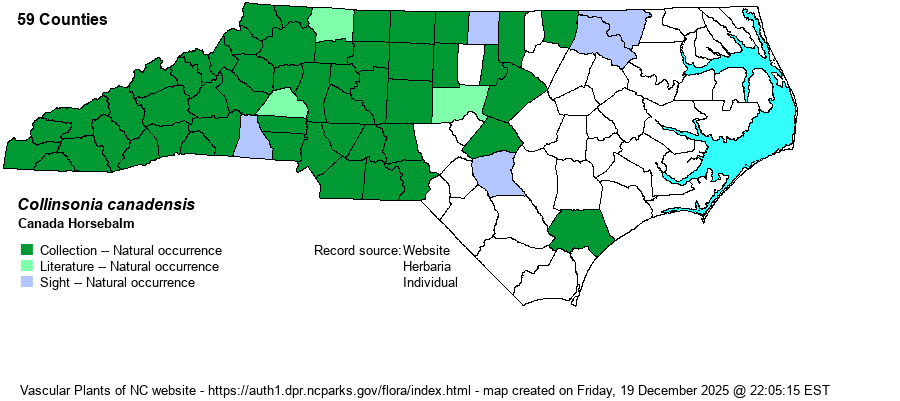| Author | L. | |
| Distribution | Throughout the Mountains and nearly all of the Piedmont. In the Coastal Plain found only along a few brownwater rivers (Roanoke and Cape Fear), plus a very rich site along Harrison Creek in Pender County.
This is an Eastern species found from New England and WI south to northern FL and eastern LA. Generally scarce on the Coastal Plain. | |
| Abundance | Fairly common to common in the Mountains and foothills. Fairly common eastward to the central Piedmont, but infrequent in the eastern Piedmont and edge of the Coastal Plain. | |
| Habitat | This is a species of rich, moist hardwood forests, usually on slopes. It favors high pH soils, and can be found in Rich Cove Forests, Basic Mesic Forests, and to some extent in Mesic Mixed Hardwood Forests. It occasionally grows in bottomlands. |
| Phenology | Blooms from late July to September, and fruits from September to October. | |
| Identification | This species is a robust and tall herb, with a thick stem, often rather bushy-looking, with several branches, though some plants can be unbranched. It has about 3-4 pairs of large opposite leaves, evenly spaced on the main stem or branches. The leaf blade is widely ovate, generally 6-8 inches long and about 4-5 inches wide, serrated on the margins, but with a petiole (often about 2 inches long) that is less than half the length of the blade. At the end of the stem is a large, open panicle of light to medium yellow flowers; some smaller panicles can occur from leaf axils. Each flower is about 1/2-inch long and strongly lemon-scented. The lower lip of each flower is extended, with much of the stamens and pistils extending beyond the corolla. An experienced biologist can identify the species just from the leaves, as the very similar but quite rare C. tuberosa has the petioles very long and over half the length of the blade. The vegetative plants can resemble a Hydrangea species, though those plants have a rounded woody stem, and not an herbaceous and square stem. This is a familiar plant of montane coves, as well as in much of the Piedmont on the richer slopes. | |
| Taxonomic Comments | None
| |
| Other Common Name(s) | Northern Horsebalm, Richweed, Stoneroot | |
| State Rank | S5 | |
| Global Rank | G5 | |
| State Status | | |
| US Status | | |
| USACE-agcp | FAC link |
| USACE-emp | FAC link |

